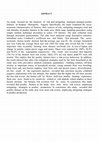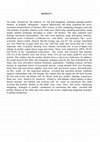Papers by ogbugh fabulous
Design and Implementation of Customer Relationship Management System
Computer Knowledge and Technology, 2015
The economic globalization,with the development of electronic commerce in China,along with the ri... more The economic globalization,with the development of electronic commerce in China,along with the rise of financial liber-alization,various types of enterprise has been also fully aware that the client is the found ation of enterprise survival and develop-ment,improving the relationship between the client and the enterprise is a necessary condition for the development of enterprise.So CRM has become an important way for the development of enterprises.The paper focuses on the analysis and design of CRM,the system is mainly based on the technology of customer information management,combined with professional knowledge and en-gineering practice.

This research paper examined the inadequacies involved in the manual method of compiling students... more This research paper examined the inadequacies involved in the manual method of compiling students’ result in secondary schools in Nigeria. To achieve that, preliminary investigations about the current manual record keeping were carried out at some selected secondary schools of Nasarawa state. The problems with the manual result processing were identified and a new system was proposed, designed, and implemented. In this work, a computer software application was developed to facilitate the automated processing of the results. The software was developed using PHP (Hypertext processor) programming language and MYSQL (My Structural Query Language), a relational database management system in designing the database; tested and found to have produced the expected results. Teachers do not need to draw vertical/horizontal lines on a broad sheet of paper for recording students test and exam scores, and also need not to do any form of calculations, as the system does virtually everything. Simil...

The study focused on the Analysis of risk and mitigating strategies amongst poultry farmers in Ka... more The study focused on the Analysis of risk and mitigating strategies amongst poultry farmers in Kaduna Metropolis, Nigeria. Specifically, the study examined the socioeconomic characteristics of farmers, their sources of risk, mitigating strategies used and risk attitudes of poultry farmers in the study area. Multi stage sampling procedure, using simple random technique procedure to select 130 farmers. The data collected were through structured questionnaire. The data were analysed using descriptive statistics, attitudinal scale, Cronbach's coefficient test and Safety first principle. The socio-economic factors results showed that the average age was 45, the average household size was 9,and the average flock size was 1445.The study also reveal that the 3 most important risks in poultry farming were disease out-break, rise in cost of inputs, and change in poultry output prices (eggs and meat). These were reported by 100%, 96.9% and 94.6% of the respondents respectively. The result also revealed that majority (70.1%) of the farmers were risk averse, while 23% are risk takers and6.9% were risk neutral. This implies that the poultry farmers have a risk-averse behaviour. In addition, the result showed that other risk mitigation strategies used by the farm household in the study area were preventive medical treatment, quarantines / building rotation, off-farm income as important source of household income, young animals from own breeding, birds from safe and known supplier, feed from safe and known source, diversification, etc.The result of the regression analysis revealed that non-farm income exhibited negative relationship with risk attitude, this implies that the higher the off farm income the less risk averse the farmer will be. House hold size, poultry farming experience, flock size were found to be positively related to risk attitude, which implies as these factors increase the farmers risk aversion will be more. In conclusion, this study revealed that poultry farmers in the study area were more risk averse, employing mitigating strategies in poultry production. In conclusion, this study revealed that poultry farmers in the study area were more risk averse, employing mitigating strategies in poultry production.
Drafts by ogbugh fabulous

Personnel Management Information System is a combination of human and computer-based resources th... more Personnel Management Information System is a combination of human and computer-based resources that results in the collection, storage, retrieval, operations and for business planning. The personnel management system of Federal College of Education Umunze uses manual process which gives room to a lot of mistakes. Computerizing it involves the total eradication of the manual method so that all information processing is performed entirely with computer system. This will increase efficiency, speed and reliability of the information. In this project, an efficient creation and management of staff records in the personnel department has been ensured through a user defined database management system, developed using visual basic programming language. The program is made to automatically update staff information, modification of records depending on when an existing staff is promoted or transferred to a new department while deleting a record, a record involves the total removal of the staff record from the computer memory as well as when a staff is retired or resigns voluntarily from service or staff dies. The new system when implemented will go a long way to correcting the difficulties faced with the manual processing, and will enhance retrieval of information within the organization. CHAPTER ONE

ABSTRACT
The study focused on the Analysis of risk and mitigating strategies amongst poul... more ABSTRACT
The study focused on the Analysis of risk and mitigating strategies amongst poultry farmers in Kaduna Metropolis, Nigeria. Specifically, the study examined the socio- economic characteristics of farmers, their sources of risk, mitigating strategies used and risk attitudes of poultry farmers in the study area. Multi stage sampling procedure, using simple random technique procedure to select 130 farmers. The data collected were through structured questionnaire. The data were analysed using descriptive statistics, attitudinal scale, Cronbach‘s coefficient test and Safety first principle. The socio-economic factors results showed that the average age was 45, the average household size was 9,and the average flock size was 1445.The study also reveal that the 3 most important risks in poultry farming were disease out-break, rise in cost of inputs, and change in poultry output prices (eggs and meat). These were reported by 100%, 96.9% and 94.6% of the respondents respectively. The result also revealed that majority (70.1%) of the farmers were risk averse, while 23% are risk takers and6.9% were risk neutral. This implies that the poultry farmers have a risk-averse behaviour. In addition, the result showed that other risk mitigation strategies used by the farm household in the study area were preventive medical treatment, quarantines / building rotation, off-farm income as important source of household income, young animals from own breeding, birds from safe and known supplier, feed from safe and known source, diversification, etc.The result of the regression analysis revealed that non-farm income exhibited negative relationship with risk attitude, this implies that the higher the off farm income the less risk averse the farmer will be. House hold size, poultry farming experience, flock size were found to be positively related to risk attitude, which implies as these factors increase the farmers risk aversion will be more. In conclusion, this study revealed that poultry farmers in the study area were more risk averse, employing mitigating strategies in poultry production. In conclusion, this study revealed that poultry farmers in the study area were more risk averse, employing mitigating strategies in poultry production.
Uploads
Papers by ogbugh fabulous
Drafts by ogbugh fabulous
The study focused on the Analysis of risk and mitigating strategies amongst poultry farmers in Kaduna Metropolis, Nigeria. Specifically, the study examined the socio- economic characteristics of farmers, their sources of risk, mitigating strategies used and risk attitudes of poultry farmers in the study area. Multi stage sampling procedure, using simple random technique procedure to select 130 farmers. The data collected were through structured questionnaire. The data were analysed using descriptive statistics, attitudinal scale, Cronbach‘s coefficient test and Safety first principle. The socio-economic factors results showed that the average age was 45, the average household size was 9,and the average flock size was 1445.The study also reveal that the 3 most important risks in poultry farming were disease out-break, rise in cost of inputs, and change in poultry output prices (eggs and meat). These were reported by 100%, 96.9% and 94.6% of the respondents respectively. The result also revealed that majority (70.1%) of the farmers were risk averse, while 23% are risk takers and6.9% were risk neutral. This implies that the poultry farmers have a risk-averse behaviour. In addition, the result showed that other risk mitigation strategies used by the farm household in the study area were preventive medical treatment, quarantines / building rotation, off-farm income as important source of household income, young animals from own breeding, birds from safe and known supplier, feed from safe and known source, diversification, etc.The result of the regression analysis revealed that non-farm income exhibited negative relationship with risk attitude, this implies that the higher the off farm income the less risk averse the farmer will be. House hold size, poultry farming experience, flock size were found to be positively related to risk attitude, which implies as these factors increase the farmers risk aversion will be more. In conclusion, this study revealed that poultry farmers in the study area were more risk averse, employing mitigating strategies in poultry production. In conclusion, this study revealed that poultry farmers in the study area were more risk averse, employing mitigating strategies in poultry production.